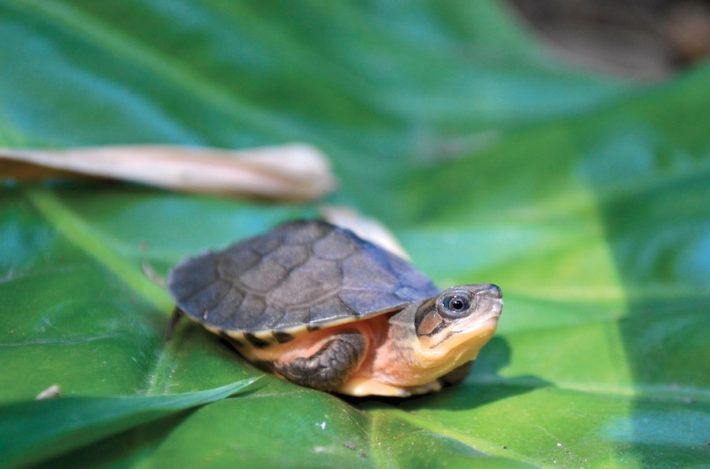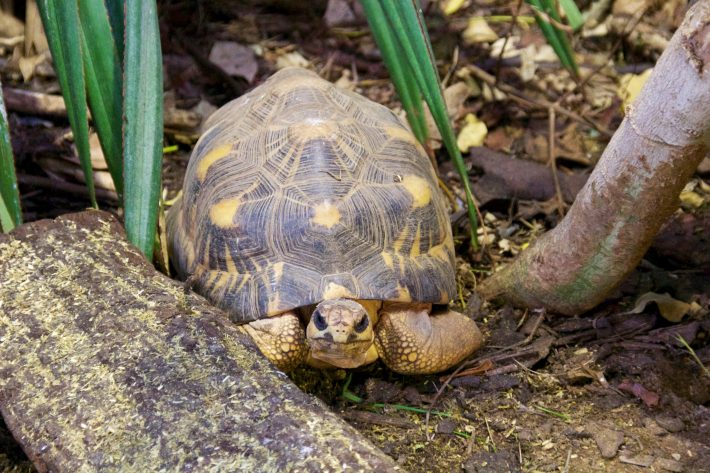Q&A: How can we save the world’s turtle and tortoise species from the wildlife trade?
“Turtles have existed for more than 220 million years; this means that they are some of the oldest creatures on the planet, having lived alongside (and long outlived) dinosaurs. Part of the turtle’s success is due to its unique survival strategy… Do we humans want to be the reason that their proven strategy ultimately fails?”

In this Q&A, the BES Press Officer Becky Allen, interviews Amanda Sigouin, the author of the recent Practitioner’s Perspective in Journal of Applied Ecology ‘Priorities for the trade of less charismatic freshwater turtle and tortoise species’
So, you say unsustainable wildlife trade remains a leading cause of population declines. Can you give me one or two examples of how drastically a turtle or tortoise species has declined and why?
One of the most well known examples of a turtle species negatively impacted by the trade is the golden coin turtle (Cuora trifasciata). The golden coin turtle also called the Chinese three-striped box turtle is a critically endangered species that is on the brink of extinction in a large part due to the wildlife trade. The turtle became in high demand after it was marketed to have cancer-curing properties which led to rampant collecting of wild individuals. While exact population estimates are not available, it is believed to be extirpated from much of its native range in China. Given the rarity and high demand for this turtle, wild-caught individuals have been priced as high as $20,000 USD.
Another example is the critically endangered ploughshare tortoise (Astrochelys yniphora), native to Madagascar, which lost much of its historical range. Some estimates say there are just 200 individuals left in the wild, putting the species perilously close to extinction. A major factor for the species’ decline is collection for the international pet trade, as this large and very beautiful tortoise is in high demand for the international pet trade.

You talk about charismatic species attracting public attention and funding. What fascinates you most about turtles and tortoises? Why is it wrong to save only those species we like the look of?
Turtles have existed for more than 220 million years; this means that they are some of the oldest creatures on the planet, having lived alongside (and long outlived) dinosaurs. Part of the turtle’s success is due to its unique survival strategy, a combination of a hard protective shell and long life span which has proven highly successful. However, these ancient animals that have proven capable of surviving in the face of so much change cannot withstand this latest test of human exploitation. Do we humans want to be the reason that their proven strategy ultimately fails? If we fail to save turtle species, we stand to lose so much of the great diversity that has evolved on earth over millions of years.
Can you tell me a bit more about turtles and tortoises – their distribution, habitats, longevity, variety etc?
Turtles and tortoises are found on all continents except for Antartica. While more turtle species are found in warm climates, some turtles in colder climates hibernate during the winter. Turtles on land will often burrow while some aquatic turtles stay under water, and are able to survive without breathing oxygen for several months.
Turtles and tortoises are some of the most long-lived creatures, with documented lifespans of over 150 years for some species. Fascinatingly, these older turtles often show minimal signs of senescence. For instance, some turtle species do not show a decline in fertility as they age; in fact, for some species, their reproductive output continues to increase into their 50s and 60s!
Freshwater turtles and tortoises come in all different sizes. The largest living tortoises are from the Galapagos Islands, with some specimens over 5 feet long and weighing in at over 550 pounds (250 kilograms). Whereas the Cape speckled tortoise, native to South Africa, is thought to be the world’s smallest tortoise with a maximum shell size of only 4 inches (11 cm) and weighs less than half a pound (140 grams).
Can you explain very simply what the anthropogenic allee effect is and its implications?
If a particular turtle species is harvested, which leads it to become increasingly rare, that rarity makes it even more desirable and valuable, in turn causing hunters and traders to seek it out more, leading to further declines (this is known as an extinction vortex).
What do we know about the size of this trade? How many turtles and tortoises are legally and illegally traded every year?
There are no recent comprehensive size estimates of the turtle trade that I am aware of. That said, turtles are a substantial commodity in the wildlife trade, with millions of dollars-worth traded. It is a truly global enterprise with turtles shipped from all over the world to Asia to supply the food markets. There are also more regional and domestic turtle food markets all around the world and a thriving international pet trade.
Why does the loss of these species matter?
As discussed earlier, turtles are remarkable species that have been around for millennia. Further, turtles are an important part of the ecosystems in which they live. The loss of turtle species could cause changes in energy flow, nutrient cycling, and the structure of the food-web. Turtles eggs, hatchlings and the occasional adult represent food for many other organisms, while the diet of turtles, including plants, small vertebrates, insects, carrion, etc. is part of a complex chain.
As far as solutions go, you talk about the need for a multi-pronged approach. Can you summarise what we need to do and who needs to do it?
We need to address the wildlife trade from both the supply and demand sides of the equation. On the supply side, we can try to increase production for the food and pet markets by finding ways to sustainably farm turtles. On the demand side, we need to work to educate people about the plight of turtles as well as the lack of any proven health benefits from consuming turtles. Lastly, we need to encourage tougher regulations and stricter law enforcement to prevent illegal activity and tougher punishments for offenders.
What are your recommendations of what you think needs to be done?
- Greater regulation of existing turtle farming to ensure sustainable supply (and to make sure they are not a further drag on wild populations)
- Stricter regulation through more consistent trade regulations and increased enforcement. Greater capacity for enforcement can come through apps such as WCS’s wildlife guardian
- Reduce demand through educational campaigns and increased enforcement of relevant regulations
And what won’t work?
Turtles’ very long life cycle makes it incredibly difficult for them to withstand harvesting pressure. This is because they have evolved a life-history strategy that includes late maturity (with many turtles not reaching reproductive age until 10–15 years plus) combined with very low natural adult mortality. Therefore, even small changes in adult mortality can have very detrimental effects.
Farming that does not take good care of the animals can lead to reduced reproductive output, therefore requiring additional wild stock, further depleting populations. Additionally, many farmers do not have the patience to raise a species for 10+ years before it reaches reproductive age. Another drawback of farming is that it can be used as a front for the wildlife trade – with illegally harvested turtles branded “farmed” to customs and other officials. This is why greater regulation is needed to ensure farms are not placing further pressures on wild populations.
While there are a few instances where sustainable harvesting works, generally it is difficult with a species with such a long life cycle, as even small annual increases in adult mortality can result in population extirpations. It appears to only be feasible when eggs or hatchlings are harvested in very modest quantities.
What will happen if we don’t act?
Many turtle species are already critically endangered due to a multitude of factors, including illegal harvesting for food and pet markets, which is often exacerbated by factors such as habitat loss and pollution. We have already lost some turtle species in the wild, and if we do not act quickly and decisively to help stem further losses, there will likely be more extinctions in the near future.
To find out more, read the freely available Practitioner’s Perspective ‘Priorities for the trade of less charismatic freshwater turtle and tortoise species’ by Amanda Sigouin, Miguel Pinedo-Vasquez, Robert Nasi, Colin Poole, Brian Horne and Tien Ming Lee published in Journal of Applied Ecology.
Like what we stand for?
Support our mission and help develop the next generation of ecologists by donating to the British Ecological Society.